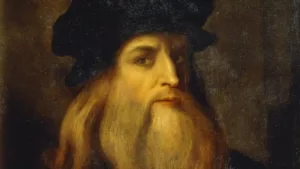 Leonardo da Vinci (1452-1519) was an Italian Renaissance artist, inventor, scientist, and polymath. Throughout history, he has been regarded as one of the most talented and versatile individuals.
Leonardo da Vinci (1452-1519) was an Italian Renaissance artist, inventor, scientist, and polymath. Throughout history, he has been regarded as one of the most talented and versatile individuals.
Da Vinci was born in Vinci, Tuscany, Italy and trained in Florence as an artist. Some of his most iconic works of art include The Last Supper and the Mona Lisa. Aside from his artistic achievements, he also made significant contributions to anatomy, botany, astronomy, and engineering.
His inventions include flying machines, hydraulic pumps, and war machines. Sketches, scientific observations, and invention ideas were also contained in his notebooks.
The work and contributions of Leonardo da Vinci shaped the Renaissance and Western art and science. He remains an enduring symbol of human curiosity and creativity.
Legacy: Leonardo da Vinci
There are several reasons why Leonardo da Vinci is considered special in history:
-
Mastery in multiple fields: He was a true polymath, excelling in numerous fields, including painting, sculpture, engineering, mathematics, anatomy, botany, and geology. He was a pioneer in fields such as anatomy and mechanical engineering, and his work in these areas laid the groundwork for future discoveries.
-
Innovative mind: Leonardo was an innovative thinker who developed ideas and concepts that were ahead of his time. His inventions, such as the flying machine and the parachute, were based on principles that were not fully understood until centuries later.
-
Mastery of art: As an artist, he revolutionized the art world with his use of techniques such as sfumato, which created a sense of depth and realism in his paintings. His iconic works, including the Mona Lisa and The Last Supper, are among the most recognizable and celebrated paintings in history.
-
Influence on culture: His work and ideas have had a profound influence on culture and society, shaping the Renaissance and the development of Western art and science. He remains an enduring symbol of human curiosity, creativity, and innovation.
As a result of his genius, creativity, and contributions to numerous fields, Leonardo da Vinci is considered to be one of history’s most influential and consequential figures.
Most Memorable Contributions
Leonardo da Vinci is most remembered for his contributions to art and science. He is widely regarded as one of the greatest artists of all time, and his most famous works include:
-
Mona Lisa: This painting, also known as La Gioconda, is perhaps the most famous painting in the world. It is known for its enigmatic smile and the sense of mystery that surrounds it.
-
The Last Supper: This painting depicts the last supper of Jesus and his disciples, and it is renowned for its composition and use of perspective.
-
Vitruvian Man: This drawing is a study of human proportions, and it is one of the most recognizable images in the world.
Additionally to his art, da Vinci made significant contributions to science and engineering. Some of his most notable achievements include:
-
Anatomical drawings: Da Vinci was one of the first people to make detailed drawings of the human body, and his work in this area contributed to our understanding of anatomy and physiology.
-
Flying machines: He designed several flying machines, including a helicopter and a glider, that were based on the principles of aerodynamics.
-
Hydraulic engineering: Da Vinci was a master of hydraulic engineering, and he designed several machines, including water pumps and irrigation systems, that were used in his time.
To this day, Leonardo da Vinci is remembered for the contributions he made to multiple fields and the enduring legacy he left behind.
Impact Today
Leonardo da Vinci’s legacy has had a profound impact on the world of today in several ways:
-
Art and Aesthetics: Leonardo’s innovative techniques, such as sfumato and chiaroscuro, revolutionized the art world and inspired generations of artists. Today, his paintings are still considered masterpieces and continue to be admired and studied.
-
Science and Engineering: Da Vinci’s scientific and engineering contributions, such as his anatomical drawings and designs for flying machines, laid the groundwork for many modern inventions and discoveries. For example, his study of human anatomy was crucial to the development of modern medical science, and his designs for flying machines influenced the development of aviation.
-
Creative Thinking: Da Vinci’s approach to creativity, which emphasized observation, experimentation, and the blending of different disciplines, has become a model for innovation in many fields. Today, his legacy inspires people to think creatively and to approach problems from multiple perspectives.
-
Cultural Heritage: Da Vinci’s work and legacy continue to be celebrated and studied around the world, contributing to the cultural heritage of humanity. His iconic works, such as the Mona Lisa, continue to attract millions of visitors to museums each year, and his influence on culture and society remains profound.
As a result of Leonardo da Vinci’s contributions to art, science, and culture, we are inspired to create, innovate, and appreciate the beauty and complexity of the world we live in today.
Final Days
Leonardo da Vinci passed away on May 2, 1519, at the age of 67, in the town of Amboise, France. The exact cause of his death is not known, but it is believed that he died of natural causes, possibly a stroke.
In the months leading up to his death, he had been working on a project for the King of France, Francis I. Despite his failing health, he continued to work on his drawings and writings until the end of his life.
Da Vinci was buried in the Chapel of Saint-Hubert in the Chateau d’Amboise, a castle where he had spent the last years of his life. His grave was later destroyed during the French Revolution, and his remains were lost to history.
Today, Leonardo da Vinci is remembered as one of the greatest minds in human history, whose contributions to art, science, and culture continue to inspire and influence people around the world.










